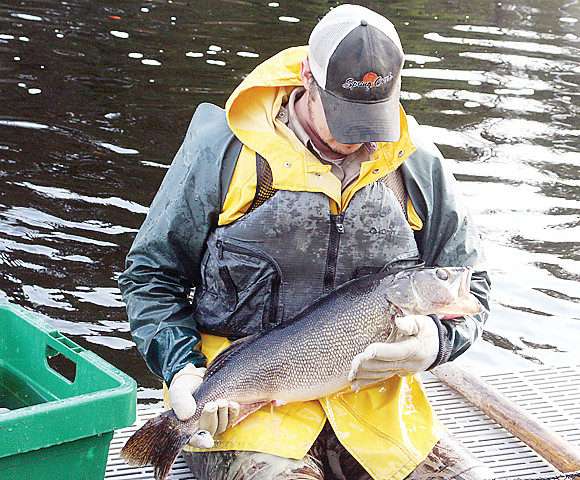Support the Timberjay by making a donation.
Hatchery takes steps to halt spread of invasives
New water filtration system, new decking added to Pike River facility
PIKE RIVER— The Department of Natural Resources dedicated extra funding for the state fish hatchery here as part of its ongoing effort to halt the spread of aquatic invasive species and to improve safety for its workers.
Perhaps the costliest upgrade is a new water filtration system, installed just recently at a cost of $70,000. According to Hatchery Manager Jeff Eibler, the filter is designed to prevent the spread of spiny waterfleas from the hatchery to other lakes that receive walleye fry from Pike River.
The hatchery is located at the mouth of the river, where it enters Lake Vermilion, and DNR officials confirmed the presence of invasive spiny waterfleas in Vermilion this past summer. Without filtration to strain out the waterfleas and their eggs, Eibler said Pike River fry would have to be limited to lakes already infested with the non-native pest. Yet as the only state hatchery within the Rainy River watershed, the Pike River facility has traditionally provided millions of fry for hundreds of lakes across a broad swath of the Arrowhead. That made the investment in new filtration a worthwhile one for the DNR, according to Eibler. “It’s the first of the state’s fish hatcheries to have such a system installed,” he said.
At the same time, the DNR retired its old and dilapidated wooden decking that fisheries staff used for decades as the base for their egg-gathering operations. The floating wooden decks were often constantly wet or even icy, which made the decks a slipping hazard for workers. This year, it’s out with the old and in with new aluminum decking, with an anti-skid surface that makes egg-gathering efforts much safer.
“It’s a big improvement,” said Eibler, even though fisheries staff didn’t have much time to enjoy it, given the quick end to the egg-gathering season. Last weekend’s dramatic warm-up boosted the pace of the annual walleye run. That, combined with a lower-than-usual quota this year, of just 675 quarts of eggs, helped the hatchery crew wrapped up egg collection on Wednesday, having collected about 680 quarts of eggs.
Hatchery staff are now overseeing the incubation of the eggs, which typically hatch in just under a month. Once hatched, the fry will be kept in large open tanks until they’re ready for release.
The lower-than-usual egg harvest this year is a reflection of area lake management plans, said Eibler, which can vary stocking levels from year-to-year. In addition, hatcheries in southern Minnesota, which used to take some of the Pike River fry to raise to the fingerling stage, are using other sources of fry this year, instead.






